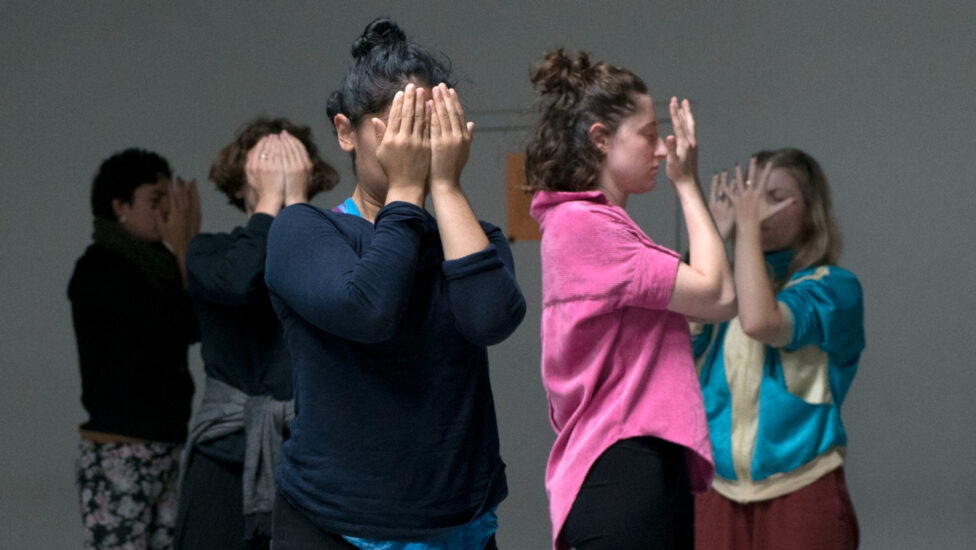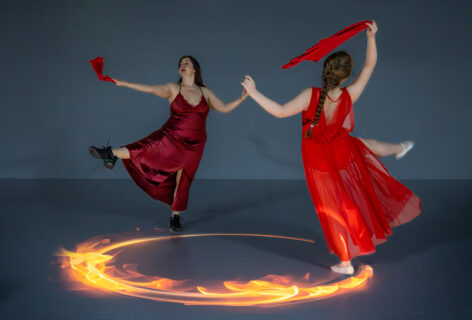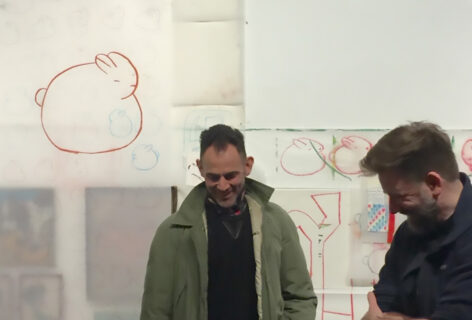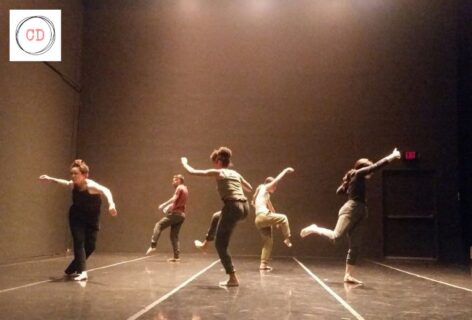Jessie Young: I’m seeing a lot of things right now as choreographic provocations. And I should define what I think of when I say “choreographic.” I think of a structure that defines itself for itself, of itself. That the choreography isn’t trying to adhere to a preexisting system, but that it’s like this is me emerging to myself of myself in a way that I’m thinking. Thinking about the choreographic structure, thinking about other larger structural questions like how are we facilitating performances? How is teaching being facilitated? I think a question for me is what does it look like to support, or hold the space of support, for a dance teaching practice.
Leslie Cuyjet: That’s why I want to talk to you. I felt so mystified by the little breadcrumbs I would get from social media about how you’re working within a teaching practice, in a class structure. I knew it was something larger than Jessie’s getting a lot of teaching gigs. There’s a driving force of searching or looking that I can’t quite put my finger on, so I wanted to sit down and talk about it. Not just tell me what it is, but because it’s been a gradual journey, a gradual shift. I wanna know what led to what, what steps you took, what’s informing your next move. I noticed something was shifting when we all met in Urbana and you were kicking off the road trip.
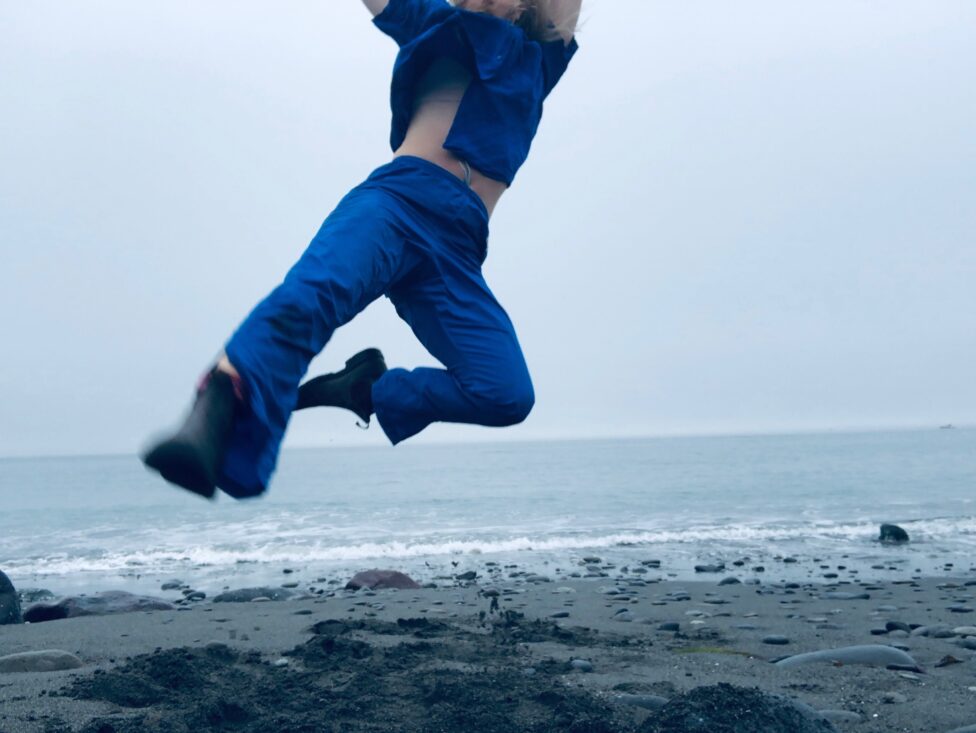
JY: With so much energy. [laughs]
LC: Without a second of hesitation, I supported your project on Indiegogo. I was like, I don’t know what Jessie’s doing but I’m 1,000% behind it. Then I’ve been peeking around the corner trying to figure where that plan came from and where you are now.
JY: There are a number of different entry points. I started to develop a teaching practice when I was dancing in high school on a dance team. The majority of the people were coming in to formalized dance [learning routines] for the first time, and I was just having a conversation about how to encounter the movement and the routines we were doing and create a space to talk about it as more of a conversation, less of a now I’m gonna put these moves on you. I co-taught these classes with my friend Keely. I felt challenged by, at odds with, and sometimes supported by the structure of a dance class.
LC: It’s a limitation.
JY: Yeah, it is. And it’s a structure that I’m aware of, in the very Westernized ways that I’ve encountered these dance practices. So that’s something that’s been riding through me. When I moved to New York, I was doing a residency with Fresh Tracks creating a work called descend sky. The work had a kind of rigor inside of it that asked for a real physical commitment from the people dancing. There was a request from the group to offer a support structure, to help them prepare to do the work. That’s when I was like, Oh ok, you want a way, — I’m gonna use the word training — on how to train for this piece. I feel comfortable using the word training because it’s something I identify with as a dancer. So I started offering a class at the Woods, and I decided to call it Techniques because what I was going to bring to the classroom was a series of techniques, and a series of different technical practices that I use in my choreography. Then I found, on a personal level, the class was the thing that helped me get me out of bed in the morning.
LC: That’s huge! To know so clearly what gets you out of bed.
JY: I was so tired, and I didn’t know what direction I was tired from. And I was feeling all kinds of self-doubt, all kinds of social anxieties about how to enter a room. I think the responsibility of creating space and holding space for a class was enough to get me out of bed, and I needed it. After a while, I reached out to Pepper at BKSD (Brooklyn Studios for Dance), and he was open to me teaching a class on Mondays, and Mondays were hard for me because at that time I was working everyday. If I was going to teach on Mondays, I needed the class to have a real vibe for me, be something I needed. There needed to be loud music, loud enough to get lost in, and it needed to be a big space, big enough to be big in and big enough to condense into. I was focusing my energy on creating a space I needed. Then it kept being something that I really want to do in a way to engage with people. I like being in a dance class.
LC: Yeah, that’s refreshing to hear because I haven’t heard that ambition before. It’s been ages since I’ve been to class. As far as my physical practice, I have this recurring injury and I was getting injured over and over and over again. I was like, what if I did a ballet barre every day for a month, and I went through plies, grand plies, tendus, degages? Four exercises and I was covered in sweat just thinking about technique, thinking about engaging those systems and modalities. I haven’t organized my body in that way in a really long time. I was like, wow I have to do this. Which translated into going to the gym a lot and doing strength training, and I stopped getting injured! That was also a system of technique, like a squat or a push-up is a different kind of technique. Instantly when I started training, my injuries went away. But I still haven’t gone to class.
JY: Not everybody needs to go to class.
LC: Not everybody needs to go to class! Do you think your familiarity with class had to do with coming out of grad school?
JY: I think that a lot of it came out of dancing in a project that required a ton of physical rigor.
LC: Interesting. Why?
JY: Because I found myself inside of a work where I had to be in close and intimate conversation with my body. Through dancing with this particular choreographer I was able to understand the ways my muscles encountered getting fatigued and then getting built back up. If I was going to move or to do a gesture in the ways the choreography required, this understanding was the pathway that would get there. I think that being inside of that for a long time, I was like this is what it feels like to stay close to something and grow inside of it. I would go to class to see my friends, I would go to class to move, because I wanted to move in big and sweeping movements. I went to take care of my body. But there was a certain point, when I was living in Chicago when I was like: What am I preparing for? What am I preparing to do? What is this about? Why am I dancing? Out of all the things that I could be doing…
LC: Whoa, that got there real fast. [laughter]
JY: …I know. But I’m like why this? And I know why this from my own history, for personal reasons because it was a space of magical thinking when I was growing up, and fantasy, and imagery. It was a place for being a kid with ADHD to make sense outside of a structure that was the public school system. It was all of these things. But I continued to choose it, and I am very consciously choosing it now, and everyday I ask myself why am I choosing this? It is an interesting challenge to continue to choose dance. Another thing that became a big energy for me creating this class, which at times I’ve called Techniques class and at times I’ve called Coming out of Retirement, right now I just like being in dance class. I’ve spent time talking with friends at different stages I’ve grown up dancing with, and the conversations were leading to places like it’s been so long since I’ve been to class. Essentially life has happened, and there is this guilt of I can’t go back. If you don’t want to go back, that’s fine. But something inside of it feels like peoples resistance to go to class points to the issues I have with the system. It doesn’t feel equipped to hold the complexities and the intelligence of a dancing body, and all of the artistry happening inside of that. Even though I don’t have the language to articulate, because it’s different for each person. It felt important for me to create a space in the language of the class that acknowledges that you may be in a place where you want to go and you just don’t feel like you can. This is a class to come to, to help you return to that practice.
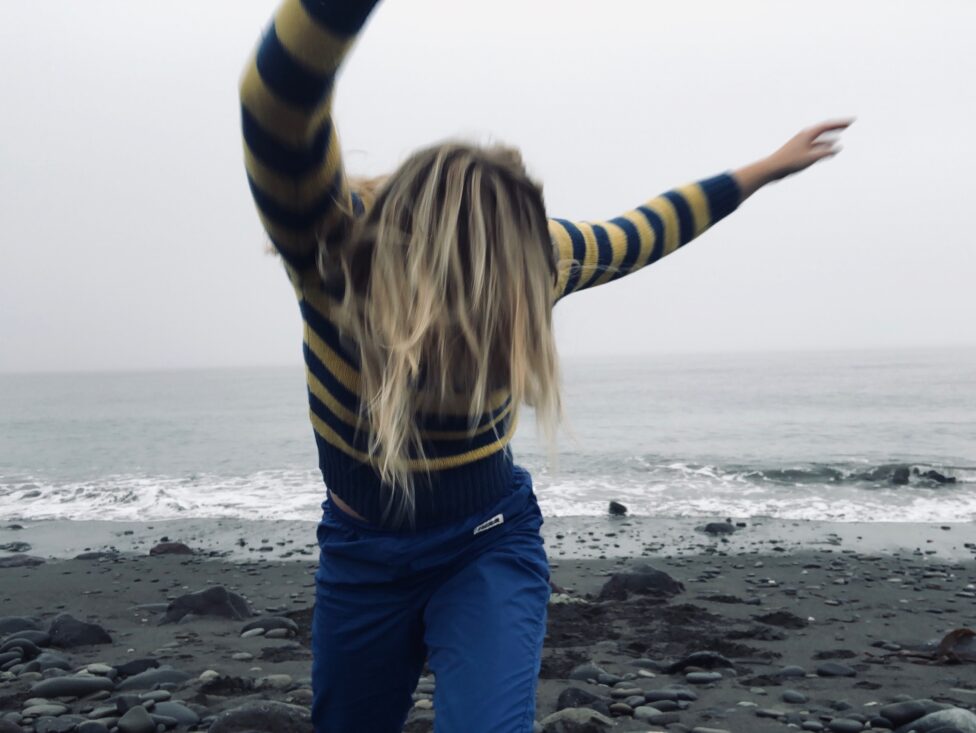
LC: That’s very clear. Whenever people say “it’s been so long” or” life happened,” we are thinking of class in the traditional sense. From what I imagine, that kind of class structure is destroyed and built up from the ashes of that old way of thinking. I’m trying to think what it was that made me stop going to class. One was the cost, $18 for a dance class. Especially when I was going uptown to ballet class, paying 18 or 16 bucks and leaving after barre. Partly because I was like I’m not good enough to stay for center, or I had to be at rehearsal, or whatever. I was like this is debilitating. I can’t do this two times a week, maybe once a week. Then I was like forget it. You have to make decisions on how you’re gonna take care of your body. It’s sometimes not what I want to do. The older I get, the more I’m realizing a lot is not what I want to do. Even just calling it class, there’s something about that word I’m resistant to. When I saw the Coming out of Retirement announcement email, I saw it as your work. I thought that was the name of a dance you were working on and touring.
JY: Oh my god, wow.
LC: [laughter] Maybe it shows you how little I pay attention to captions.
JY: I was just having this conversation about something I find myself doing if I’m doing too many applications. You’ve landed on a word or a phrase that speaks to you or what you are, but there is no there there. You’ve named it and it’s a symbol, and you’re going to have to continue to move through this word to make sense of it. The language I was using was a way of describing my teaching as the bedrock for my choreography.
LC: That’s why, it hit me about a year ago, I was like why am I not teaching? Because it’s the most intimate way to get to know your practice: to give it away and to see it reflected back to you.
JY: I have to say, I don’t always know if the reasons for my teaching are model reasons. For a long time, teaching was a thing that kept me moving before I was taking antidepressants. I just needed to be moving. The class fed off my manic energy, it fed off my ego, and it fed off a deep desire to find approval in every way and feel a sense of belonging in New York. There are so many ways the primary engine for the class was ego driven, in its design I was creating a class that I would want to come to. It’s centered on me. But something happens each time I’m in the room that really levels me and drops me in, because I feel that I’m just excited by being with other people in a room together working on something together.
LC: Is that different than performing? Because I feel similarly to what you described but within performance. Being with people in this shared thing for a time.
JY: It does have that. I mean they talk to each other for sure.
LC: But in your experience in performing, are you like Oh I recognize this feeling.
JY: Yeah, I like to be watched. That’s one of the reasons why social media came up as a big thing for me. You want a witness, you want to be seen doing what you’re doing. Being in a class and being with other people and wanting to be seen doing your work, is different than dancing alone in my room. Also to challenge the fact that I can’t kick my own ass. There’ve been moments in performance where my breath lives in a different register, it wants to move up higher. I don’t always feel like I can drop in, in performance in the same ways I can drop in, in class.
LC: You teach a lot more often than I perform but whenever I get the opportunity to perform, I have to relearn how to do it over and over again. It’s like an Instagram post as opposed to a story: in teaching you get to just go and sketch on Mondays for a month and try and see how it goes. Whereas for performance, you work for three months, or six months, or a year for one weekend. No studio showing or work-in-progress will equal that consistency.
JY: This comes back to what I was going to say before. I talk about this in class, the snake eating its tail. The conversation’s eating itself right now. I don’t think right now that teaching is the bedrock of my choreography. [laughter]
LC: This is application-speak versus…
JY: Yeah. I’m realizing they’ve separated. Maybe they’ve always been separate and I haven’t been acknowledging it. Because there is a different way I’m encountering myself as a performer, than the way that I teach.
LC: Do you know what that is?
JY: I think of it for myself. I’m definitely at a stage in my choreography, and right now, my choreography is me performing it. It’s a practice of looking at how I trust myself and truly how that looks as a process. What does it look like to trust and move instinctively through things that are coming out of me and not wanting to resist it? Which is why I’m creating a solo so I can face myself inside of this. When I’m in class, the timing of exercises is much quicker than the timing I sense for my dances. The images and provocations are very much entangled, but the weight of time and what I ask it to “do” feels much more disparate. I take class differently than how I teach class. I don’t know if I’d always want to take my class. I love the interiority of class, I love to be with people, but I love being in the back of the room. Jennifer Nugent taught a class back in the spring, and she started class off like “we’re gonna walk around the room–” which is a familiar way to start a class, “–and you’re just gonna look at the floor,”
LC: So deeply satisfying…
JY: … and every part of me was like thank you, I needed this moment. Sometimes I just want to have permission to look at the ground and let that be an experience. When I’m teaching another energy comes out in me, that’s seeking approval and wants to create energy.
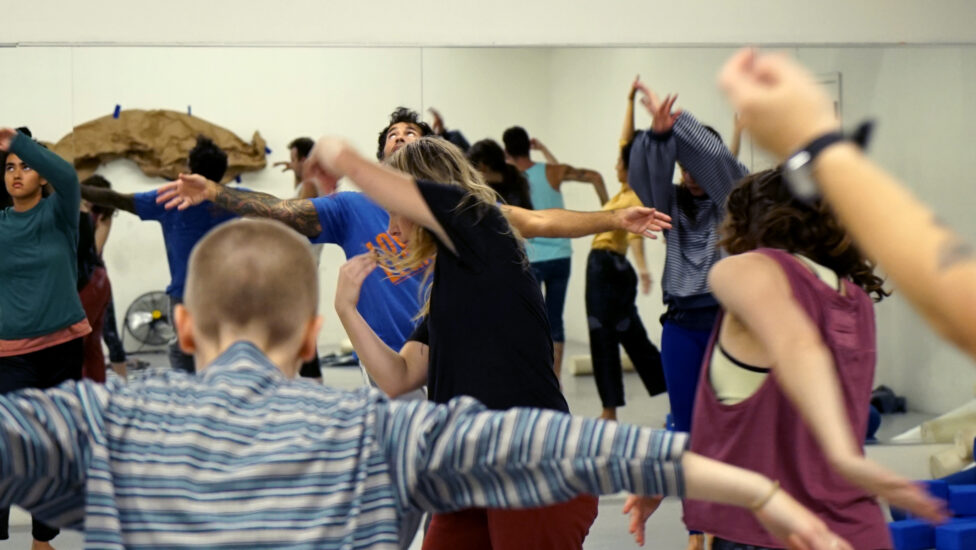
photo: The Fleet
LC: That spark that is ignited through the collective in class, then it becomes a collective experience. It’s interesting that you mentioned you took Jennifer Nugent’s class, I also took her class last summer for a MELT workshop, and I haven’t taken technique class 5 days in a row in forever and I felt that I wasn’t “good” at class. I’m not putting a value system on that but by day three I started to feel more comfortable. It was almost a cultural experience noticing who’s standing in the front, who’s standing in the back, who wants to demonstrate, who’s marking and who’s going full out everytime, who’s asking questions and who’s not asking questions. By not taking class consistently, I realized I was out of practice. You could be more familiar going through the motions, or the cultural expressions to stay on the metaphor, of class. So I was enjoying her class while standing in the back and not asking too many questions, almost as resistance to make up for my lack of skill of taking class in a more traditional sense. And even in this resistance to play along, I was still able to engage.
JY: That sounds very powerful. When I’m teaching, a real driving force for me is to acknowledge that all of this is happening and these are provocations I’m bringing into this room, and the experience is going to be a dispersal. How are we collectively and individually bringing ourselves into those invitations and choosing to exist or not exist inside of them? To enter into a room like Ok I’m here. But when I say “powerful” that is such a complex and ideal way to exist in a class. Here I am in this class, of this class, of this material, as me. It’s becoming real through the interaction. This is a space to see yourself inside of. I’ve been focusing on this in my teaching: observe how you encounter the room, how you learn, observe how you think, observe where your mind goes. Are you observing class or looking out the window, do you want to be in the center, do you need the attention? And the deep challenge of seeing it and not trying to change it or fault yourself for it, but to believe that that’s what the room is for.
LC: Just to hear that someone is thinking of it that way, looking at it that way, teaching class that way is really powerful.
JY: That’s why I don’t want “powerful” to sound like a dismissal. I feel very strongly about this. I don’t always feel like there is language to support what it looks like to be 100%, 30%. That’s a quote from someone.. It’s in my notebook.
LC: I love that.
JY: One of the things I like to go back to is what the muscles of the core actually are. The pelvic floor, the transverses, the diaphragm, the multifidus, and the ringleader of these core muscles is the diaphragm. You’re breathing. That muscle is always working. As long that muscle is working the other muscles are working. Which means, if you’re alive, you’ve been working this long. We’re sentient beings breathing and working, I don’t know if it gets much more fucking rigorous than that. When I’m about rigor, breathing is rigorous, being vertical is rigorous. Existing in the world is a rigor.
LC: Getting out of bed…
JY: Getting out of bed is a rigor. Yes, there are certain things out of habit, from training, out of cyclical patterns I’m enmeshed in and I want to try different physical things. Breathing is an absolute powerful move. I wish for myself and my classes to include the language of be in the room. Be in the room and let yourself be more present. That’s what I mean by 100% 30%. There have been times when I want to be in the room but if I move my arm I’m gonna cry and I don’t want anyone to see me cry. It’s important to me that there are spaces that exist where I can go and be of myself and of the space. A dance class can be one of those spaces because a dance class can be a choreography of itself. Some classes are for a particular training, that’s fine. For myself, the choreography of my classes is grappling with what is it to exist on different spectrum or a scale of rigor or self-awareness.
LC: I work with improvisation a lot, and in that practice, I’m constantly asking myself where I’m at and if I want to, what is neutral today, whatever neutral is, and how do I push up against that or bring more into it. Figuring out first thing where I’m coming into the room is at the heart of what I’m practicing. Is it 31%, is it 28? I’m seeing some similarities in the work that you’re doing as facilitator/teacher to what I’m still understanding my work as facilitator in rooms of the people that I work with, and because I didn’t necessarily …
JY: I’m with you.
LC: How do I say this? I used to call “My Work” my choreography, when really the thing that I’ve been doing for the last 15 years, was dancing for other people mostly as collaborator in the room. It’s been really hard until this [Bessie] nomination to justify and acknowledge it as Work. Now that I’m hearing you talk about your teaching practice as Practice, as something you return to and refine, where you come from, where you are, it sounds really familiar to how I approach people’s studios, people’s rehearsals, My Work.
JY: Oh my god, yes.
LC: I’m in other people’s rehearsal processes so that I can engage with in my work, I need to be in another process if I’m going to be in my process. I just am. That’s another similarity of you taking class to understand your class. To be in both of those roles gives you a holistic perspective of that experience. When I’m showing my work I take seven shits a day I get so nervous. I feel like an impostor all the time because I’m like am I a choreographer? But I think I’m trying to negotiate how do I show My Work from this other side, as a performer.
JY: Two simple things. I recently took a class where someone in the room referred to us as artists and I could feel the whole room shift just by acknowledging a student taking class as an artist. I think dancers are infantilized. I started dancing at a very young age and for a long time played into the “I’m just a person, I don’t understand,” because that was my safety in rooms. When I think back to that part of myself, I’m like she knew so much from feeling so much. There wasn’t always the invitation to start from there. That’s a whole other thing, invitations. Now I’m branching off, for one time I thought of calling a class I was teaching Invitations and Permissions because I was like fuck that! I’m not gonna wait for any more invitations or permissions.
LC: Yes!
JY: The other simple thought came from when I was teaching yoga, I remember someone saying when you teach you’re learning, when you’re learning you’re teaching, when you’re the teacher you’re the student, and when you’re the student you’re the teacher. There’s a lot about that I enjoy. I love to talk, and I love to be in conversation in a dance room because I trust myself there. When I’m teaching I’m there to facilitate. I’m there to be a support. How am I a support? Is this about me right now? Or just about the room? dance is my “people” practice. I grew up in the northwest, and there’s a reality about people sticking to themselves, sticking to their homes, not knowing your neighbors. Going into a dance class was a place to be with other people.
LC: In a quite outright kind of way.
JY: Yeah, and there are things that happen there that don’t happen in other spaces. I like to put out a sounding board like, if this resonates with you, then this is a thing that’s happening. I want to go back to something else that you said in the beginning talking about the Remember This tour.
LC: Where you went across the country, and you had several stops along the way?
JY: With the exception of LA, I went back to all the places that I have lived, and in part because I had lost touch with those people. I might regret using this word, but I do often think of teaching as an offering. It’s a thing that moves through me that I’m moved by in my life, I’m moved to teaching by love. What moves me to teach is having come through teachers that have shaped me, that I‘ve been loved by, and come to know my love inside of. So it is a love-based practice, it is a joy-based practice at its root. It was at a time where I wanted to go back to places where I’ve lived and offer classes. I did a fundraiser for it, but I was not keeping the proceeds to the classes I taught. Money from the classes went back to the places that were hosting the class (personal homes & dance studios), I wanted to be back in community with these people/places. Acknowledging that these people grew me into an artist. Predominantly in Seattle and Chicago and Salt Lake City, doing house shows with different friends and groups. I wanted to go back and participate in them. That was what that connection was for me.
LC: I’m grateful that you were able to go through that offering, because you can see it here how it’s shaped what you’re doing here. I just want to be clear, I have not taken your class, I’m excited to learn about it and enter the conversation.
JY: But we’ve been in rooms together. I think the main thing is, I love you, but I don’t fucking care.
LC: [laughs]
JY: I mean, truly.
LC: I mean it’s not just about showing support for you as my friend. I’ve been so curious about your work and this conversation is my answer. I just want to be clear that I’m coming from a place of ignorance having not experienced it, but there’s still deep respect from this outside perspective. Even though I haven’t taken it, I see Seattle in your class. I see it!
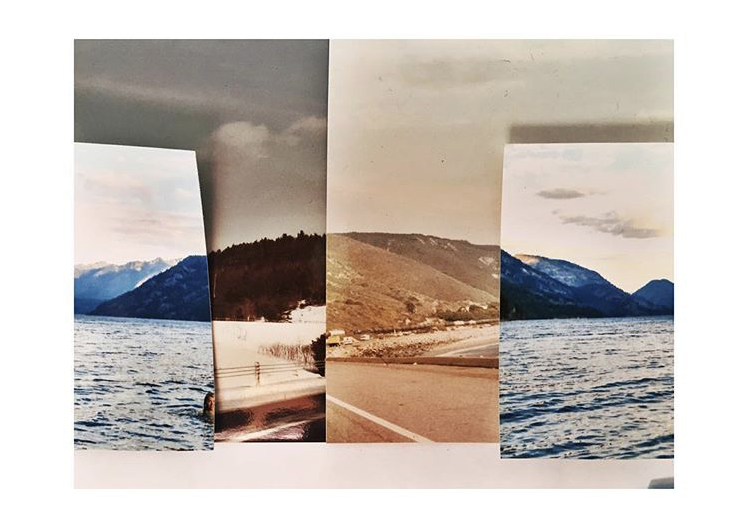
JY: Because I’m hitting you over the head like, “Ocean, ocean, do you get it? Ocean. Look at the names of my pieces, ocean, ocean!” Images of the PNW come alive to me because I grew up in that landscape while I was learning about my body, seeing that I had a torso, learning about a landslide. So when I need to speak of experiences of my body, the language of the landscape comes with me. I have a photographic practice, I’m interested in what image is, what it can do inside of its failings, because it’s a failure in itself. I’m interested in the challenge of the impulsive happenings of social media in blasts. The challenge of being a late millennial is to be really careful in how much I build myself based on my own reflection and how much I rely on it. I love to work with image, I love to think about how images relate. I like to include imagery in class, like it’s as much about this drippy moss, as it is about seeing this movement. I like to put those things side by side. It’s its own energy. I want you to say it, because I don’t want you to feel like I don’t care about your presence. I do. I’m saying to you we come to things when we come to them and life moves in cycles.

